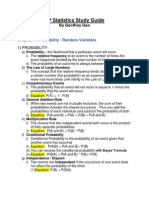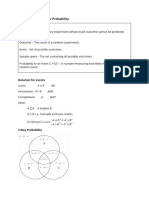0 ratings0% found this document useful (0 votes)
4 viewsFinal Midterm 1
statisctis midter,
Uploaded by
maria margatoCopyright
© © All Rights Reserved
Available Formats
Download as DOCX, PDF, TXT or read online on Scribd
0 ratings0% found this document useful (0 votes)
4 viewsFinal Midterm 1
statisctis midter,
Uploaded by
maria margatoCopyright
© © All Rights Reserved
Available Formats
Download as DOCX, PDF, TXT or read online on Scribd
You are on page 1/ 2
Random variable: specific value Sample: smaller group taken from the population to study.
- Discrete: specific (#sons: 1,2,3) * Parameters: Population characteristics (mean, variance).
Bernoulli: 1experiment; 2 outcomes (success or failure)
Binomial: # successes in a fixed # independent trials
Simple Random Sampling: Every individual has an equal
Poisson: # events in a fixed interval
chance of selection.
- Continuos: any value (temperature)
Uniform: every outcome in a given range is equally likely. Sampling Biases: Occur due to non-random sampling or
Exponential: models the time between events in (Poisson) measurement errors.
Normal: symmetrical; bell-shaped curve; large range
Sampling Distribution of the Mean: A distribution of
Probability distributions: sample means.
- Mass: discrete (prob of a value) Expected Value of Sample Mean = Population Mean.
- Density: continuos (likehood)
- Distribution: x<= value Central Limit Theorem (CLT):
With a large enough sample size, the sampling distribution
Expected value E(x) = Mean = : average value
Variance: how much the values differ from the mean of the sample mean becomes normal.
Standard Deviation: √ var ; spread around the mean np(1-p) > 5
Covariance: Measures the direction of the linear relationship the distribution of the sample mean approaches a normal
between 2 random variables. distribution as the sample
+++ cov :variables move in the same direction n var
--- cov: variables move in opposite directions
Correlation: Measure of the strength and direction of the linear
relationship between 2 variables, ranging from [-1 ;1]
Mean = X = P(x=0)*0 + P(x=1)*1 + P(x=2)*2 ….
Conditional probability distribution of y given x=3:
P(x=3 e y=0) = P(3e0)/P(x=3) --- isto para todos os dif y (somar
todos)
Cov (xy) = E(xy) - x * y
E( 70 + 2x) = 70 + 2*E(x) ------------------------------------------------------------------
cov ( xy ) Estimator: Formula or rule to calculate an estimate.
corr (xy )=
σx∗σy Estimate: actual value obtained using the estimator.
Average = to the parameter being estimated
E( 70 + 2x) = 70 + 2*E(x)
Unbiased: If the expected value of the estimator equals the
VAR(ax1 + bx2) = a 2VAR (x1) + b 2VAR(x2) + 2ab*cov(x1x2) true parameter. ---- x = x1
Bias: The difference between the estimator's expected
P(z<1.2) --- NORM.S.DIST(1,2 ; true) value and the true parameter.
P(x < z < y) = P(z<y) – P(z<x) Consistency: sample size increases, the estimate gets closer
P(z>1,2) = 1 - P(z<1.2)
to the true value of the population parameter.
P(z< - 1.2) = 1 - P(z<1.2)
- Bias approaches 0: The estimate is less and less
wrong as you ask more people.
x −μ
Z= - Variance approaches 0: Your guesses become
σ more reliable.
σ =√ VAR( x ) Efficient: smaller variance
Relative Efficiency: Ratio of variances between two
μ=n∗p estimators. (var u2/var u1 e var u3/var u1)
Minimum Variance Unbiased Estimator (MVUE): Unbiased
2
σ =np(1− p) estimator with the lowest possible variance.
------------------------------------------------------------------
------------------------------------------------------------------
Descriptive Summarizes data (mean, median, standard
deviation), describes a dataset.
Inferential: predictions about a population based on a
sample (hypothesis testing, confidence
intervals).
Population: The entire group you're interested in.
You might also like
- Strategic Management in Public Administration PDFNo ratings yetStrategic Management in Public Administration PDF27 pages
- Abductive Thinking and Sense Making - Jon KolkoNo ratings yetAbductive Thinking and Sense Making - Jon Kolko11 pages
- Revision - Elements or Probability: Notation For EventsNo ratings yetRevision - Elements or Probability: Notation For Events20 pages
- MAT 211 Introduction To Business Statistics I Lecture NotesNo ratings yetMAT 211 Introduction To Business Statistics I Lecture Notes69 pages
- Everything You Ever Wanted To Know About Statistics: Prof. Andy FieldNo ratings yetEverything You Ever Wanted To Know About Statistics: Prof. Andy Field37 pages
- 67c9d235eca2bdbebab746da_AP Statistics Cheatsheet (2025)No ratings yet67c9d235eca2bdbebab746da_AP Statistics Cheatsheet (2025)2 pages
- F (A) P (X A) : Var (X) 0 If and Only If X Is A Constant Var (X) Var (X+Y) Var (X) + Var (Y) Var (X-Y)No ratings yetF (A) P (X A) : Var (X) 0 If and Only If X Is A Constant Var (X) Var (X+Y) Var (X) + Var (Y) Var (X-Y)8 pages
- Learn Statistics Fast: A Simplified Detailed Version for StudentsFrom EverandLearn Statistics Fast: A Simplified Detailed Version for StudentsNo ratings yet
- Utilization of Library Resources by Lecturers in UNo ratings yetUtilization of Library Resources by Lecturers in U8 pages
- Labour Welfare Measures in Neyveli Lignite Corporation Limited NeyveliNo ratings yetLabour Welfare Measures in Neyveli Lignite Corporation Limited Neyveli4 pages
- Updated Xuanqi's International MArketing NotesNo ratings yetUpdated Xuanqi's International MArketing Notes46 pages
- Effects of Tecar Therapy On Adipose Tissue Clinical TrialNo ratings yetEffects of Tecar Therapy On Adipose Tissue Clinical Trial12 pages
- Proposal ICT Final. Fatmawati M. Tika B. and Nurhikmah S Kelas ANo ratings yetProposal ICT Final. Fatmawati M. Tika B. and Nurhikmah S Kelas A26 pages
- PDF Good Design Practices for GMP Pharmaceutical Facilities Second Edition Terry Jacobs download100% (2)PDF Good Design Practices for GMP Pharmaceutical Facilities Second Edition Terry Jacobs download55 pages
- The Oxford Handbook of Environmental Criminology. (2018)No ratings yetThe Oxford Handbook of Environmental Criminology. (2018)898 pages
- Standards of Professional Practice (SPP) On Pre-Design Services SPP Document 201No ratings yetStandards of Professional Practice (SPP) On Pre-Design Services SPP Document 20151 pages

























































































